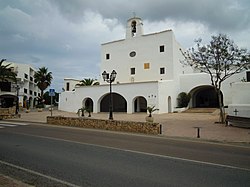Sant Josep de sa Talaia
Sant Josep de sa Talaia | |
|---|---|
Village | |
 | |
|
UTC+2 (CEST) | |
| Website | Town council website |

Sant Josep de sa Talaia (Catalan:
The Parish Church of Sant Josep de sa Talaia
In the early years of the 17th century the population of village had grown considerably. At this time the nearest place of worship was at Sant Antoni de Portmany and the local population needed a church somewhat closer to their homes.[2] In 1726 the inhabitants of the area then named es Vedrans and Benimussa asked the archbishop of Tarragona, Manuel de Samaniego y Jaca, who was visiting the island, to approved the building of a new church. The archbishop agreed to this request and on 15 August 1729 the first mass was held on the site.
Construction
A master builder from
Visiting
The Parish Church of Sant Josep de sa Talaia is one of the most popular churches to visit on the island. Many holidaymakers find their way here as part of official island tours. Unfortunately many of the churches original religious art works were damaged or destroyed in the violence of the
Points of interest
- Michelin 2-star restaurantconsidered the most expensive in the world
See also
- The Municipality of Sant Josep de sa Talaia
- Sa Caleta Phoenician Settlement

